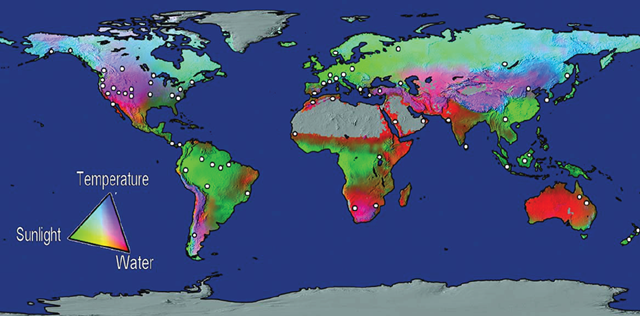Graph of the Day: Locations of Forest Mortality Related to Climate Stress from Drought and High Temperatures
White dots indicate documented localities with forest mortality related to climatic stress from drought and high temperatures. Background map shows potential environmental limits to vegetation net primary production (Boisvenue and Running, 2006). Only the general areas documented in the tables are shown—many additional localities are mapped more precisely on the continental-scale maps. Drought and heat-driven forest mortality often is documented in relatively dry regions (red/orange/pink), but also occurs outside these regions.
At broad spatial scales, drought-related forest mortality has been reported near species geographic or elevational range margins where climatic factors (particularly water stress) are often presumed to be limiting (Allen and Breshears, 1998; Foden et al., 2007; Jump et al., 2009; Fig. 1; Fig. 3 and linked Box 1). Spatially extensive die-offs are commonly associated with prolonged water deficits, such as in savanna and temperate conifer forest vegetation types during multi-year droughts (Fensham et al., 2009; Fig. 10). Notably, however, drought-induced mortality is not restricted to forests typically thought to be waterlimited, as highlighted by events in tropical rainforests of Borneo where stand-level mortality reached as high as 26% after the severe El Niño in 1997/1998 (van Nieuwstadt and Sheil, 2005), or the Amazon basin in 2005 (Phillips et al., 2009). Mortality in ever-wet and seasonally dry tropical rainforests appears to be relatively diffuse and incited most often by short but extreme seasonal droughts (Fig. 10). In temperate forests, short (seasonal) droughts may be more likely to induce dieback of broadleaved (deciduous angiosperm) trees (Fig. 10) than conifer (evergreen needleleaf) treesbecause of their increased vulnerability to xylem cavitation (Maherali et al., 2004).
